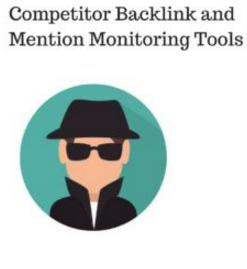As a business, do you apply tactics for monitoring your competition? There are lots to learn from customer insights with this technique.

In business, you always need to know what your competitors are doing. To survive, you must perform competitive intelligence activities.
You must monitor the broader market for new developments that could affect your company. They include products and brands, suppliers, and distributors.
Tracking your competitors is the only way to make sure you are thwarting threats. And including taking advantage of opportunities, marketing effectively, and, ultimately, winning in the marketplace.
By performing competitive intelligence, you will significantly increase your margins and profitability.
There’s one resource that’s often underutilized in this regard: your competitors’ websites.
Today’s digital footprint is increasing corporate transparency and yielding greater power to consumers. In the marketing dialogue, the footprint enables marketers to measure conversions.
Companies spend enormous sums of money on maintaining their websites. This enables them to attract and influence prospects, customers, and analyst.
And it’s all too easy to get to that place.
But like Sun Tzu said in The Art of War, you need to know your enemy. That applies as much to business as it does to battle.
And the easier you make the project for yourself, the more likely you’ll be to follow through.
The easiest option? Building a dashboard to track the competition, all in one place.
With one monitoring dashboard, you can track all your competitors individually in one place. With it you can bring in results from tons of sources.
Your time spent on competitive analysis will go from “Googling with a side of insights” to “analysis with equal parts action.”
We’ve already decided it’s crucial to monitor your competitors online. How do you get started?
Want to be recognized for your outstanding content? Then it’s crucial you continually monitor the competition.
From revealing opportunities to highlighting failures, competitor analysis gives you invaluable insight. These insights show what works and what doesn’t. They enable you to track how you’re performing against others in the industry.
Here’s some advice for setting up your alerts and building your listening strategy.
Tactics for monitoring your competition … why you should track competitors
If you’re wondering why you should go to the trouble in the first place, here are a few reasons:
Use more sources of data for making smart, data-driven decisions. Don’t just analyze your content, bring it in from your competitors’.
You’re able to watch your competitors’ business strategies play out. Analyzing them helps you learn from others’ mistakes and avoid making them yourself.
Constantly knowing the pulse of your industry and niche, makes it easier to come up with new ideas.
Just like you can learn from their failures, tracking your competitors can also help you figure out their strategy and keys to success.

Different ways to use a competitor monitoring dashboard:
Marketing strategy
Monitor their profiles to see their social media and engagement strategies.
Look at what kind of content they’re creating, how it’s distributed, and who’s linking to it. Then see what they’re doing with influencer marketing.
Public relations
Track your competitors’ PR coverage and campaigns.
See which bloggers they’re working with, and how. Build a relevant media list based on the journalists that write about them.
Business development
See what consumers think of your competitors’ products and how they handle customer support.
If you see an unhappy customer, it could even be a sales opportunity!
Use these 10 competitive analysis strategies
Identify competitors
To begin, know your enemy. You can’t expect to get ahead of your competitors if you don’t know exactly who they are. You must know what their mission is, and how they plan to execute it.
Your biggest competitors may not be who you think they are.
Search engines no longer base comparable companies on size. Just because a company is small, doesn’t mean that they won’t be dangerous to your business.
Take the time to jot down a list of your biggest challengers by searching your top keywords in search engines.
The first 10-20 most common competitors on the list are most likely your biggest threat. Those are the companies you’ll want to closely analyze to learn what they’re doing right for such high rankings.
Tactics for monitoring your competition … assess their websites
Next, make sure your website is the best. You can gauge competitor performance and generate new ideas for your website. Do this by performing a close analysis of competitors websites.
In general, you’ll want to look closely at their home page. Also examine their user interface, speed, performance, and content.
If their sites are ranking higher than you for the same keywords, they must be doing something right. If better in all categories, this means that your website is not the best, after all.
Try to identify the positive features these websites have that yours doesn’t. Then make a plan to try out some of those strategies in your marketing plan so that you can get better.
Uncover their keywords

A tool like SpyFu can reveal the keywords your competitors are targeting for paid and organic search.
Once revealed, you can use this information to identify any keywords they’re you are currently missing. Then you can jump on the opportunity to target these phrases.
Analyze their rankings
Once you’ve determined the keywords, your competitors are aiming for, use an SEO ranking tool like AccuRanker to track your progress against them.
You can also use the tool to see how your competitors are performing against your target keywords, if different than those above.
In instances where competitors are outranking you, check their website. Look for any supporting content helping them to rank. Is it something (e.g. a guide) you could do better?
Research most popular content
BuzzSumo allows users to search for the most socially shared content by topic, as well as by brand.
By entering a subject, or keyword, you’ll be served a list of content, ordered by popularity. This allows you to see if your competitors are performing well enough to appear in this list.
This helps you identify competitors you hadn’t considered before.
Additionally, this tool is great for highlighting the best pieces of content produced by your known competitors.
Input their URL for a list of their most shared content.
Stay up to date
Google Alerts are an easy—and free—way to monitor the competition.
Set up alerts for particular keywords to see who is regularly appearing on them. These alerts also alert you to branded alerts for your competitors.
It’s also worth creating notifications for your branded terms, to track sentiment and manage brand reputation.
Follow their social media activity
By keeping an eye on the social channels and posts of your competition, you’ll gain insight into what they’re sharing. You will also learn how they’re talking to customers, and which topics are performing well, and not so well, for them.
There are various ways to do this, the easiest and cheapest of which is to set up Facebook and Twitter lists.
Like or follow your competitors’ pages on relevant social channels. This will permit organizing them into lists. This way, you can easily monitor their content by clicking through to the list regularly.
No need for you to visit their profile page or relying on it appearing in your news feed organically.
To track everything a competitor is posting, use a social listening tool like Hootsuite.
This tool allows you to set up streams focusing on specific profile pages, as well as hashtags.
Read their blogs
Monitoring blog content produced by your competitors is a great way to spark ideas for the content of your own.
If they have a newsletter you can subscribe to, do so to keep on top of their latest posts.
Create rules within your inbox to ensure their emails go into specific folders. This allows you to sift through them in your own time.
Note any topics that are doing well to help shape your calendar. If there are any regular posts that perform well, think about them. How could you incorporate something similar?
From tracking your competitor’s keywords and rankings to monitoring their blog and social posts, you can get valuable ideas. This regular competitor analysis will help you to keep on top of what’s popular within your industry.
Keeping an eye on what your competitors are doing across all verticals will raise your game. You’ll be well on your way to ensuring your content remains stronger than the rest.
Subscribe to competitor newsletters
Finally, listen in on your competitors’ online conversations. Monitor the content they share on social networks and subscribe to their newsletters and email marketing.
To throw the enemy off the scent, use a private email to collect the information rather than a company one.
This will let you in on some of the biggest topics your target audience enjoys. It will also alert you of any new strategies or developments. This will let you know when it’s time to revamp your strategy to compete better.
It’s important to monitor competitor website traffic. It’s an often overlooked aspect of digital marketing.
Want to know exactly how you can compete in the crowded online market? One of your first steps should always be to learn from the adversary. This will improve your strategy to surpass theirs.
Monitor trade show events
Trade shows can take a big chunk out of a company’s marketing budget, so it is important to know which shows your competitors participate in.
Regularly review the events page on their websites and maintain a spreadsheet with names, dates, and locations of future shows. You can then see which ones you might want to sign up for.
If you spot one of them at a new show, you might ask yourself, “why are they exhibiting at this show?”
It might be an indicator of a new market they are entering. Perhaps it is one that you should consider as well.
The bottom line
This setup will give you everything you need to start analyzing marketing strategies. It gives you media lists, and generates leads based on what your competitors are (or aren’t doing).
By creating optimized alerts, and analyzing your results, you can track competitors. You can use insights to grow your business. All in one tool, all in a few minutes.
